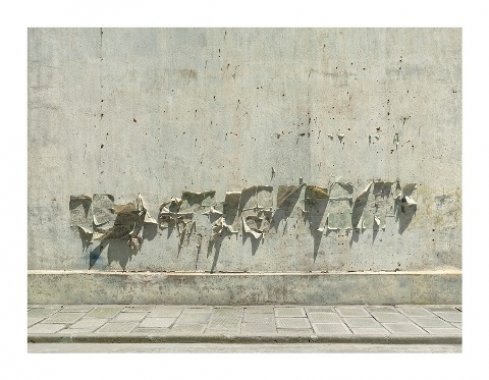Visions & Contaminations
between East and West
in harmony with Carlo Scarpa
Exhibition curated by Francesca Valente
Walls that talk and listen
Ljubodrag Andric creates large-scale photographs that dominate the entire field of vision, absorbing the viewer. Their
visions linger on architectural details devoid of the human figure and are shot frontally, highlighting the metaphysical
fixity of the walls and the horizontality of the lines that continue beyond the margins of the image. The walls Andric
presents may be bare, but they are not silent. Abstract and naturalistic elements merge as the colourful backgrounds
reminiscent of abstract painterly techniques are abruptly interrupted by details of concrete reality. Slowly we notice
patches of damp creating a bloom of discolouration, imperfect layers of cement, cracks reaching across the façade, a
resilient tuft of grass, or an incongruously placed door handle. These urban landscapes absent of any physical human
form invite reflective contemplation as the walls are there, but not those who built them or those who lived behind
them. Thus they challenge the viewer into engaging with a space inhabited by potential relationships, as we explore
new visions and imbue the photographs with personal meaning and value. The dialogue generated by these images is
further extended to include the space in which they are exhibited, the Fondazione Querini Stampalia, an inspiring and
celebrated work of the architect Carlo Scarpa.
Francesca Valente, the exhibition curator and former director of the Italian Cultural Institutes in San Francisco, Toronto,
Vancouver, Chicago and Los Angeles, points out that, “in the context of the Fondazione Querini Stampalia, Andric
interacts with Carlo Scarpa in a dimension suspended between the East and the West, and intrinsic to Venice. His glance
is attracted particularly by the hidden garden, the ideal place for an inner journey, however incomplete or tenuous.
As a result, the images create a path of effective emotional synthesis, which takes the form of a complex and layered
personal identity. We are presented with a wealth of suggestions and memories, observations and reflections, that
appear paradoxically remote and familiar, ancient and contemporary.”
Tobia Scarpa, an architect like his father Carlo, also contributes to the accompanying text of the exhibition as he
observes the dialogic potential of photographs. He notes, “In the powerful images by Ljubodrag Andric […] form and
human heritage are investigated in a manner devoid of pretence or presumption that invites curious and reflective

